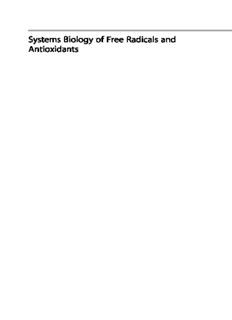
Systems Biology of Free Radicals and Antioxidants PDF
Preview Systems Biology of Free Radicals and Antioxidants
Systems Biology of Free Radicals and Antioxidants Ismail Laher Editor Systems Biology of Free Radicals and Antioxidants With489Figuresand117Tables Editor IsmailLaher DepartmentofPharmacologyandTherapeutics UniversityofBritishColombia Vancouver,BritishColumbia,Canada ISBN978-3-642-30017-2 ISBN978-3-642-30018-9(eBook) ISBN978-3-642-30019-6(printandelectronicbundle) DOI10.1007/978-3-642-30018-9 SpringerHeidelbergNewYorkDordrechtLondon LibraryofCongressControlNumber:2014932045 #Springer-VerlagBerlinHeidelberg2014 Thisworkissubjecttocopyright.AllrightsarereservedbythePublisher,whetherthewholeorpartof the material is concerned, specifically the rights of translation, reprinting, reuse of illustrations, recitation,broadcasting,reproductiononmicrofilmsorinanyotherphysicalway,andtransmissionor informationstorageandretrieval,electronicadaptation,computersoftware,orbysimilarordissimilar methodologynowknownorhereafterdeveloped.Exemptedfromthislegalreservationarebriefexcerpts inconnectionwithreviewsorscholarlyanalysisormaterialsuppliedspecificallyforthepurposeofbeing enteredandexecutedonacomputersystem,forexclusiveusebythepurchaserofthework.Duplication ofthispublicationorpartsthereofispermittedonlyundertheprovisionsoftheCopyrightLawofthe Publisher’s location, in its current version, and permission for use must always be obtained from Springer.PermissionsforusemaybeobtainedthroughRightsLinkattheCopyrightClearanceCenter. ViolationsareliabletoprosecutionundertherespectiveCopyrightLaw. The use of general descriptive names, registered names, trademarks, service marks, etc. in this publicationdoesnotimply,evenintheabsenceofaspecificstatement,thatsuchnamesareexempt fromtherelevantprotectivelawsandregulationsandthereforefreeforgeneraluse. While the advice and information in this book are believed to be true and accurate at the date of publication,neithertheauthorsnortheeditorsnorthepublishercanacceptanylegalresponsibilityfor anyerrorsoromissionsthatmaybemade.Thepublishermakesnowarranty,expressorimplied,with respecttothematerialcontainedherein. Printedonacid-freepaper SpringerispartofSpringerScience+BusinessMedia(www.springer.com) Preface Theabsoluteroleofoxygenforcellviabilitycomeswiththeburdenofcoincidental generation of free radicals (McCord 2000). It is increasingly recognized that managing the damage that free radicals can inflict on biomolecules plays an important roleinevolutionandthatatleastsomeofthevariationinorganismlife histories reflects different resolutions of the cost-benefit trade-offs involved (McCord 2000). We need to understand better why there is biodiversity in the processesandoutcomesoffreeradical management andtheadaptivevalueofthe differencesthatweseeamongorganisms.Thiswillprovideimportantinsightsinto thefactorsthatregulatefreeradicalgenerationandtheconsequencesthereof.Free radicals are not all bad – they play important roles in normal cell signaling, cell survival,andimmunedefenses(Dro¨ge2002;Valkoetal.2007).However,wenow knowthataugmentedfreeradicalgenerationoccursinseveraldiseases,particularly inanexperimentalsetting,thusleadingmanytoconsidertheuseofantioxidantsin either a preventive manner or even as a treatment for a wide variety of diseases (Briegeretal.2012;Olshanskyetal.2002).However,therecontinuestobeadebate abouttherelativebenefitsofantioxidanttherapy,particularlyinotherwisehealthy individuals (Bast and Haenen 2013; Gutteridge and Halliwell 2010). Recent reviews also draw attention to the use of antioxidants in a possibly misguided wayintryingtoslowtheageingprocess(Moyer2013). Thereisnoshortageofexcellentreferenceguidesforabetterunderstandingof the detection and analysis of free radicals, particularly in isolated cell systems. ReferenceworksbyProfessorBarryHalliwellabound,inparticularFreeRadicals in Biology and Medicine published by Oxford University Press, first produced in 1985andnowinitsfourthedition,publishedin2007,whichimmediatelycomesto mind and is justifiably considered the premiere textbook in this area. Free radical biologymustalsobeconsideredinabiomedicalcontext,sothatcommonmecha- nisms and applicability to model organisms/humans can be better understood. Tothatend,weneedabettergraspoftheunderlyingbiodiversityintheseprocesses and the adaptive value of the differences among organisms. The chapters in this collection,writtenbyexpertsintheirrespectivefieldsaimtoaddressthesegoals. Therealizationthatfreeradicalsparticipateinthemalfunctionofalmostevery body system, and the evidence garnered from the increasing use of molecular techniques, has spurred leading experts to contribute to this collection of review articles on the importance of free radicals to organism function and on their v vi Preface biological effects in disease pathology of body systems. This systems biology approach focuses on the biological role of free radical generation during disease progression, stimulating the search for newer and more effective antioxidants (Murphy 2013). The increasing appreciation of the importance of free radicals in biology and disease mechanisms has also led to the suggestion that this subject shouldbeincludedinmedicalandgraduatestudentcurricula(Kalyanaram2013). One interesting trend is that many antioxidant-rich food products are now gaininginpopularity,particularlyinJapan,theUSA,andChina,wheretotalsales ofsuchproductsexceeded$32billionin2009(TheWallStreetJournal).Accord- ingly,itisnottoosurprisingthatsomeestimatethatnearlyhalfthepopulationinthe USAconsumesantioxidantsupplementsonadailybasis.Infact,NorthAmerican, WesternEuropean,andAsiaPacificcountriesarethoughttoaccountformorethan 90%ofantioxidantconsumption,andtheprojectedgrowthinemergingmarketsis thoughttobeabout7%peryear.Recentmarketresearchsuggeststhataboutathird of US consumers buy grocery products that claim to have benefits related to antioxidant capacity. The question remains: Is this a beneficial, fruitless, or dangerousdevelopment? Twoormorecontentexpertshaveindependentlyreviewedeachchapterinthis collection;mysincereappreciationgoestothesereviewers.IwouldberemissifI failedtoexpressmyheartfeltgratitudeforthetirelesseffortsofalltheauthorsand their colleagues in producing these illustrated chapters. They have opened new avenues for interested graduate students, foundational scientists, and clinicians interestedinfreeradicalbiologyinmanybodysystems. There are many topics that have not been included in this collection, and with that oversight comes the omission of the contributions of many content experts fromvariouspartsoftheworldthatalsoshouldhavebeenpartofthiscollection.In choosing the topics and chapters herein, deliberate efforts were made to be inclu- sive of the widest range of subject matters and geographical locations, so representingtheglobalinterestinfreeradicalbiology. December2013 I.Laher Vancouver,BC,Canada Burlington,VT,USA References Bast A, Haenen GRM (2013) Ten misconceptions about antioxidants. Trends Pharmacol Sci 34(8):430–436 BriegerK,SchiavoneS,MillerF,KrauseK-H(2012)Reactiveoxygenspecies:fromhealthand disease.SwissMedWkly142:113659.doi:10.4414/smw.2012.13659(Published17Aug2012) Dro¨ge W (2002) Free radicals in the physiological control of cell function. Physiol Rev 82(1):47–95 GutteridgeLMC, Halliwell B(2010)Antioxidants: molecules,medicines,andmyths.Biochem BiophysResCommun393(4):561–564 Preface vii KalyanaramanB(2013)Teachingthebasicsofredoxbiologytomedicalandgraduatestudents: oxidants,antioxidantsanddiseasemechanisms.RedoxBiolo1(1):244–257 McCordJM(2000)Theevolutionoffreeradicalsandoxidativestress.AmJMed108(8):652–659 MoyerMW(2013)Themythofantioxidants.SciAm308(2):62–67 MurphyMP(2013)Antioxidantsastherapies:canweimproveonnature?FreeRadicBiolMed. 2014Jan;66:20–3.doi:10.1016/j.freeradbiomed.2013.04.010.Epub2013Apr18. Olshansky SJ, Hayflick L, Carnes BA (2002) No truth to the fountain of youth. Sci Am 286(6):92–95 TheWallStreetJournal.Researchandmarkets:globalantioxidantsmarket:trends&opportunities 2013–2018.http://online.wsj.com/article/PR-CO-20130704-903204.html Valko M, Leibfritz D, Moncol J, Cronin MT, Mazur M, Telser J (2007) Free radicals and antioxidantsin normalphysiological functions andhumandisease. IntJBiochem CellBiol 39(1):44–84.Epub2006Aug4 Acknowledgments I have been blessed with lasting friendships, inspirational teachers, enduring colleagues, and a wonderfully loving family that continue to enrich my life. Many of these people have passed on, but their influences remain. To everyone who have done so much, with no expectation of anything in return ... this is for you. ix
Description: